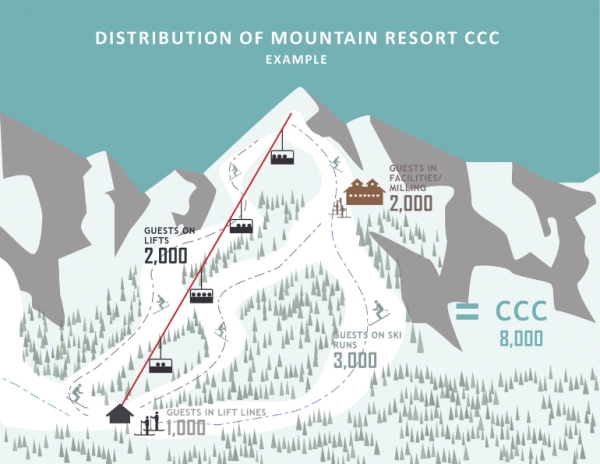Mountain resort capacity has become a popular and important topic in both the ski industry and in mountain towns. The high-profile Park City, Utah, case, in which lift upgrades were denied due to a lack of parking on peak days, is a prominent example. While this case has drawn the spotlight, there is certainly a larger issue to be discussed: the community-wide capacity of mountain resorts and their surrounding communities.
When it comes to visitation, economic impact, and capacity, the relationship between mountain resorts and their surrounding communities has always been vital. The fortunes of each has always affected the other. However, with unprecedented demand for mountain resorts, outdoor recreation in general, and the mountain town lifestyle, both resorts and communities are seeing remarkable growth and accompanying growth pains.
Raising awareness about capacity overall can only be a good thing. Our hope is that more dialogue between mountain resorts and their surrounding communities will foster a greater mutual understanding, leading to functional strategies for community-wide capacity management.
The Park City case, covered in detail in a SAM Headline News article titled “Capacity Management, Parking Brought To Fore In Park City Suit,” saw the Park City Planning Commission uphold an appeal of a permit to upgrade two chairlifts. A subsequent appeal led to a court decision that upheld the Planning Commission’s ruling.
One of the issues addressed in the case overall was capacity, and comfortable carrying capacity (CCC) in particular. This brought the question of CCC to the forefront, with questions about what it is and how it is used. The time seems right to address some of these questions.
WHAT IS COMFORTABLE CARRYING CAPACITY?
Balance is the goal. CCC is a planning parameter that we at SE Group (known until 2000 as sno.engineering) developed decades ago to help with the planning and design of a balanced resort. It refers to a level of use that provides a pleasant recreational experience, ensures that capacities are balanced across facilities, and that the facilities are sufficient to meet anticipated demand. It often reflects around the fifth- to twentieth-busiest day at any resort. Peak-day visitation exceeds CCC by 25 percent or more at most resorts.
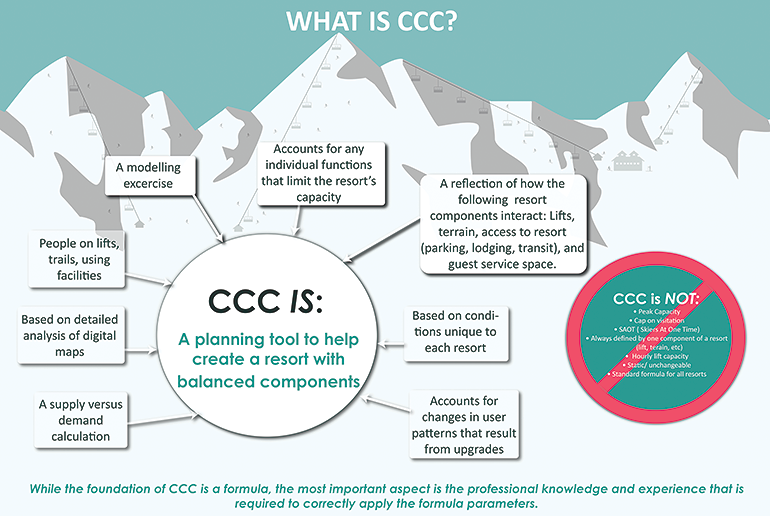
Note that CCC is a planning figure only. It is not synonymous with “capacity” in general, nor is it intended to represent a cap on visitation, though it was interpreted that way in the Park City case.
Other metrics. There are many ways other than CCC to calculate the capacity of various other community components. For example, a parking requirement could be determined by a town to be a function of the number of residential units in a development, or the number of seats in a restaurant.
In relation to this, the capacities of other components of a mountain resort (the parking, the restaurants seats, etc.) can certainly dictate the overall capacity of a resort. If, for example, the parking lot capacity does not balance to the CCC, then visitation levels will be dictated more by the parking capacity.
HOW IS CCC CALCULATED?
The calculation begins with lift capacity. CCC is fundamentally a supply versus demand calculation. It begins with comparing the lift system’s vertical transport capacity against the demand for vertical skiing by guests. This is the single most important factor in the planning and design of a resort, as it is used to balance all other resort capacities, including elements like parking, restaurant seating, base lodge size, and even things like number of ski rental units.
Determining the actual uphill capacity of each lift can be complex and challenging. For example, the delivered capacity of a lift will usually be lower than its design capacity. (This is addressed well in the July 2018 SAM article “Know your Capacity.”) Lifts slow and stop occasionally, the rate of which is influenced by many factors.
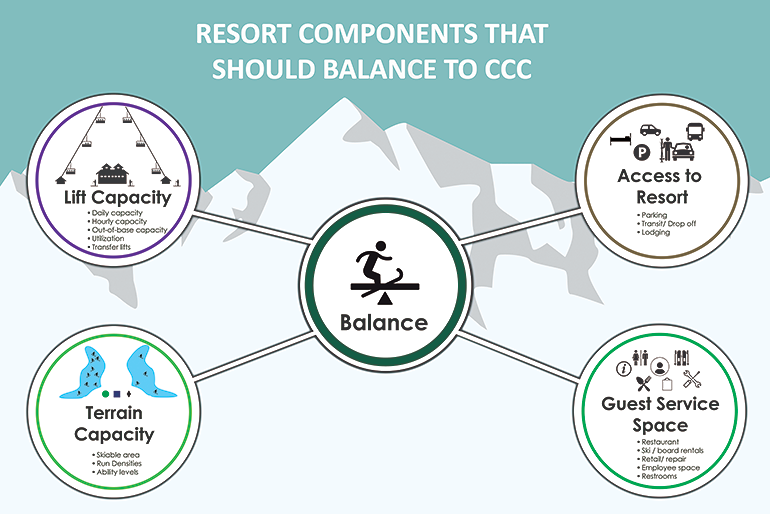
There are other considerations, too. Additionally, some lifts are installed partially or primarily for access to other parts of the mountain. In that case, the reduced effectiveness of the lift’s hourly capacity for satisfying vertical demand of repeat skiing will reduce its delivered hourly capacity below its designed hourly capacity.
The calculation of vertical demand also involves predicting skier flow characteristics. This is based largely on the ski terrain and the skier ability levels served, and is unique to each specific lift at the resort. An extensive amount of professional knowledge and experience is required to accurately determine both numbers in the equation.
Know, too, that CCC is dynamic and can change in response to a variety of factors. Clearly, lift modifications or upgrades will change the CCC; the same is true for the addition of new skiable terrain off a lift (which can change skier flow and usage, and therefore vertical demand), the upgrade of neighboring lifts (which can alter utilization patterns of the lifts) and the addition of lifts and terrain that are accessible from the lift (reducing repeat use of the lift).
Where is everybody? Another key use of CCC is to examine the distribution of guests on the mountain. The CCC number is divided among people riding on the lifts, those in lift lines, those actively skiing, and those using the guest service facilities or milling areas. Calculations of these individual components can then help clarify skier densities on the ski terrain and the appropriate size of facilities, among other factors. It can also highlight differences between resorts and infrastructure choices.
Express vs. fixed-grip impacts. For example, a resort with five fixed-grip quad lifts will have approximately twice as many people actively riding lifts at any given moment than a resort with five detachable quad lifts in the same alignment and hourly capacity. This is because detachable lift carriers (individual chairs) are spaced farther apart. On a fixed-grip lift, with carriers spaced closer together, there are more carriers—and more people—on the line at any given moment. This greater number of people actively riding lifts significantly changes the distribution of people on the mountain, with implications for all other components.
HOW IS CCC USED BY A RESORT?
We use the CCC number as the basis for achieving balance between the capacities of numerous resort components, including:
- parking/transit/lodging;
- guest service space and restaurant seating;
- terrain capacity; and
- lift capacity.
CCC can also be used to help create a certain type of experience. For example, if the desire is to create a spacious feel on the mountain, then the mountain can be designed to have a higher CCC than the other components (such as parking and base area skier service space), assuring that visitation will be lower than CCC (as business levels often seem to be more determined by the capacities of the base areas than the on-mountain infrastructure). Two well-known examples of this are Deer Valley and Sun Valley, which were both originally planned and designed to have a mountain CCC that exceeds visitation levels.
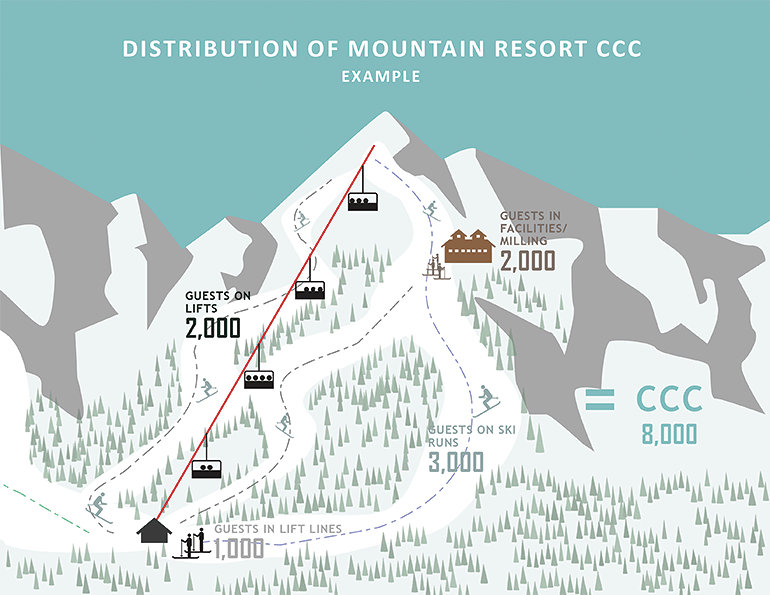
WHAT CCC IS NOT
As stated earlier, CCC is not a maximum, or peak day, capacity. It is intended to represent a visitation level where all the components are utilized fully, but lines are minimal.
There is no set number of days when peak day capacity will exceed CCC, or a maximum percentage above CCC for a peak day. Peak day visitation is accommodated by having a higher number of skiers per car, longer lift lines, and people eating lunch at outside tables, for example. By definition, daily visitation is expected to exceed CCC numerous times per year. It is not financially viable to have a capacity high enough to accommodate peak day crowds without any lines. This holds for virtually all commercial establishments, not just ski areas.
The fact that CCC does not represent a peak capacity makes it unlike many other capacity models used by communities, which are meant to serve as a limit beyond which functional problems can arise. Examples of these would be road capacity, transit capacity, and building capacity.
WHAT DOES A PEAK DAY LOOK LIKE?
There currently exists no standard metric for determining maximum occupancy at mountain resorts. Perhaps the best way to determine that number would be something more like the way that restaurants, commercial spaces, sports facilities, or amusement parks calculate it—by dividing the area of a space by a prescribed unit of area per person.
For example, maximum occupancy is already known for buildings at resorts, as required by building/fire code. Maximum occupancy of lifts and lift mazes is known. Terrain capacity can easily be calculated by multiplying acreage by density.
Using these parameters, the calculations below for maximum occupancy were done on a resort with a previously calculated CCC of approximately 7,500.
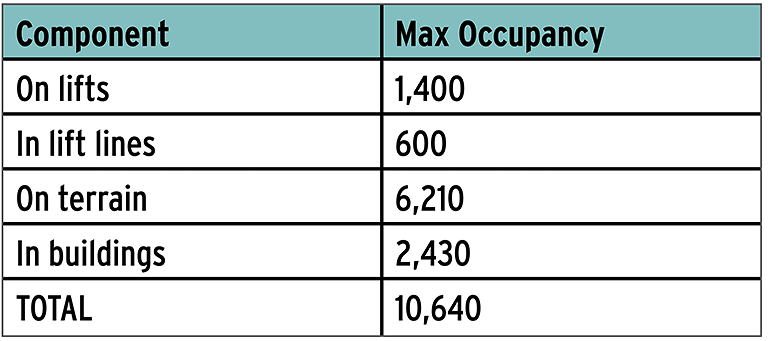
In this example, the “maximum occupancy” number is approximately 40 percent higher than the calculated CCC. (Note that this calculation is only including people on the developed ski runs—that is, not in the trees or open bowls—and is not accounting for people who may be eating lunch in their cars, etc. A category could be included for factors like those.)
HOW SHOULD CCC BE APPLIED?
There are numerous examples of CCC being used as a part of larger community capacity planning.
One example is the previously mentioned Park City case. In this instance, CCC was interpreted as a peak day capacity limit—which is not how we typically use CCC. However, CCC calculations were incorporated into a 1996 Development Agreement between the resort and the town, which ultimately became part of the rationalization for the Park City Planning Commission’s decision.
Parking capacity was also addressed in the decision, reflecting the reality that the infrastructure with the lowest capacity can be the limiting factor on the overall capacity of the resort and community. That highlights the need to balance the capacities of all the community’s infrastructure.
Another example: All mountain resorts on U.S. Forest Service (USFS) lands are required to have a current master development plan (MDP). Every MDP is required to have a discussion of capacity to ensure a proper balance of facilities and appropriate extent of use of public lands. This is a wise use of the CCC calculations.
A COMMUNITY-WIDE VIEW
Some communities have taken the USFS MDPs and used the CCC numbers as part of their dialogue regarding visitation levels. For example, the Town of Vail, Vail Mountain, and the USFS, have set up a “manage-to” number. Whenever visitation to the area exceeds 19,900 people, it triggers a conversation between the parties to discuss the situation and any needed restrictions. That number is below the CCC of the mountain, but is a number that has long been established as an effective capacity for the town. This is a good strategy and fosters effective communication between the parties.
Reaching the limit. Ultimately, many of the overcrowded community situations in recent years revolve around cars, mostly with overflowing parking and congested streets. Transit, and ways to reduce car use, are critical future topics of conversation for most mountain communities.
Fundamentally, we see CCC being applied for three general purposes:
To continue to provide a planning basis for mountain resorts to help ensure that facilities are balanced and, for those on public land, respectful of the use of that land.
To provide a clearer picture of how a resort intends to deliver its guest experience, which can inform broader conversations with surrounding communities about the broader impacts of those plans.
To encourage a greater alignment between resort operations and broader community and regional planning capacity metrics, recognizing that the resort experience doesn’t end when you leave the resort property.
Our hope is that more agreements can be discussed between mountain resorts and their surrounding communities to encourage communication, transparency, and positive outcomes. Hopefully, CCC calculations can be one component of those conversations. But not the only one.





